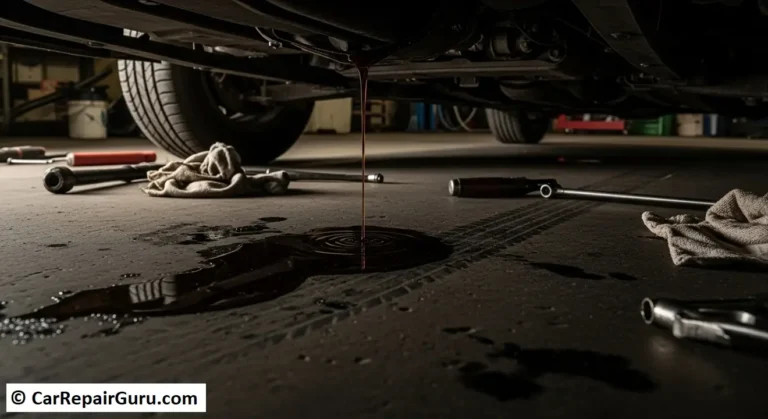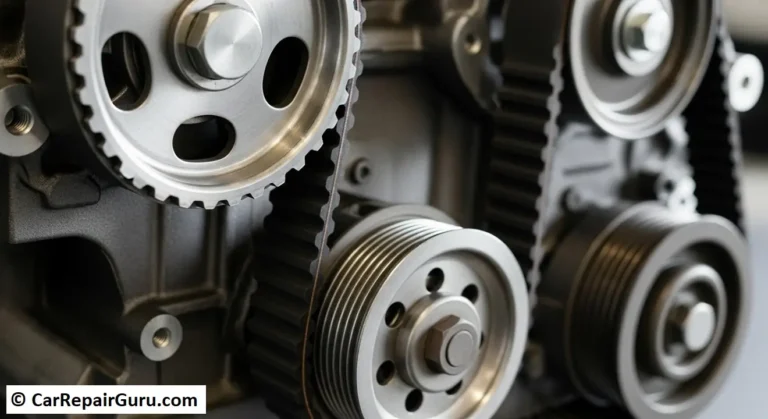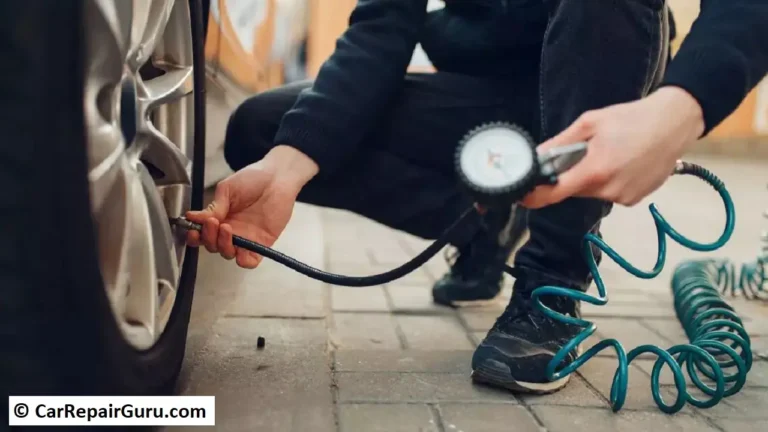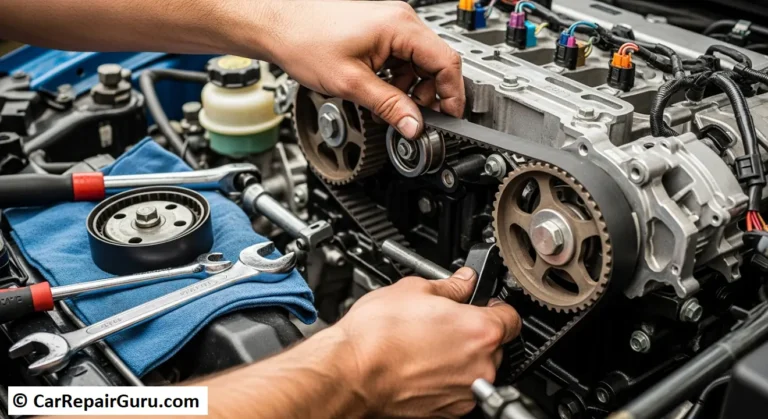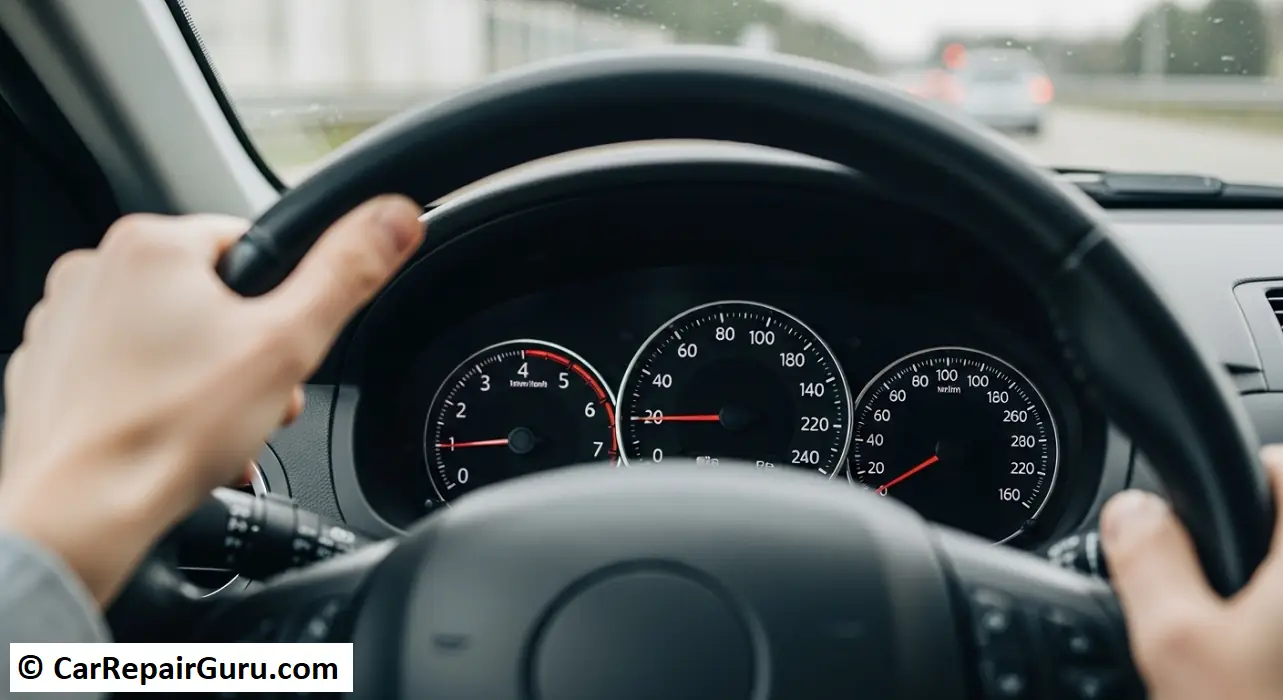
There are few things more unsettling than feeling your car start to shake. Whether it’s a subtle tremble at a stop light or a violent shudder as you get on the highway, an engine vibration is your car’s way of sending you a clear message: “Something isn’t right.”
Ignoring it won’t make it go away. In fact, that small shake can be an early warning for a problem that could become much more serious—and expensive—if left unchecked.
But don’t panic. You’ve come to the right place. This guide is designed to be your ultimate resource for understanding engine vibrations. We’ll help you decode what your car is trying to tell you, walk you through the most common causes, and give you the knowledge to decide on your next steps.
What Kind of Vibration Are You Feeling? (A Symptom-Based Guide)
Before you can fix the problem, you need to play detective. The biggest clue to the source of the shake is when and how it happens. Different scenarios point to different culprits. Let’s break down the most common situations.
Vibration at Idle (Shaking While Stopped)
Does your car feel like it’s about to stall at a stop light? A rough idle where the entire vehicle shudders is a classic symptom. When you’re parked or in neutral and the engine is shaking, the problem is almost certainly related to the engine itself or the parts holding it in place. The most common suspects are worn-out motor mounts, failing spark plugs, or a leak in a vacuum line.
Vibration When Accelerating
If the shake only appears or gets significantly worse when you press the gas pedal, you’re looking at a different set of issues. A car that vibrates when accelerating is often dealing with a problem that’s being put under stress. This could be an engine misfire that only happens under load, a clogged fuel filter starving the engine of gas, or a problem outside the engine, like a damaged CV axle or an unbalanced driveshaft.
Vibration When the A/C is On
This is a very specific clue. If your car runs smoothly until you turn on the air conditioning, and then a noticeable vibration starts when the A/C is on, the problem is likely tied to the A/C compressor. When the compressor kicks on, it puts an extra load on the engine. If the compressor is failing or the engine’s idle speed can’t compensate for the extra work, it can cause a significant shake.
Vibration at High Speeds
A car shaking on the highway, especially at speeds above 50-60 mph, is one of the most common complaints. While this can sometimes be engine-related, the number one cause is much simpler: your tires. Unbalanced tires are the primary reason for high-speed vibrations. Other possibilities include a bent wheel, worn suspension components, or an issue with the driveshaft.
Top 7 Engine Problems That Cause Shaking
While other parts can cause a car to shake, problems originating in the engine bay are a primary source. If you’ve determined the vibration is likely coming from the engine itself, here are the most common culprits.
1. Worn or Broken Motor Mounts
Think of motor mounts as the shock-absorbing cushions for your engine. These rubber and metal mounts hold your engine securely in the car’s frame while absorbing the natural vibrations it produces. Over time, the rubber cracks and wears out. When a motor mount fails, that cushion is gone, and the engine’s vibrations are transferred directly to the frame of the car—which you feel as a powerful shake, especially on startup and at idle. Other bad motor mount symptoms include a loud “clunk” when you accelerate or shift gears.
2. Spark Plug & Ignition System Issues
For your engine to run smoothly, every cylinder needs a precise mixture of air and fuel, ignited by a spark at the perfect moment. If a spark plug is old, fouled with oil, or the ignition coil that powers it is failing, that cylinder won’t fire correctly. This is called an engine misfire, and it’s like a runner trying to sprint with one leg. The imbalance creates a noticeable shaking or stuttering, especially felt during a rough idle or when accelerating. This is often accompanied by a flashing Check Engine Light.
3. Fuel System Problems
Your engine’s spark is useless without the right amount of fuel. A problem in the fuel delivery system can starve the engine, causing it to sputter and vibrate. A clogged fuel filter can restrict gas flow, while dirty or failing fuel injectors can prevent fuel from being sprayed into the cylinders correctly. This often results in a vibration that worsens as you ask the engine for more power.
4. Unbalanced or Damaged Belts & Pulleys
Your engine has a complex system of belts and pulleys that power everything from your alternator to your water pump. The main belt is called the serpentine belt. If this belt is frayed, cracked, or if one of the pulleys it spins on is damaged or misaligned, it can create a rhythmic vibration that often changes with engine speed (RPM). You might also hear a distinct squealing or chirping sound along with the shake.
5. Vacuum Leaks
Your engine relies on a carefully controlled vacuum to operate correctly. This vacuum is maintained by a network of rubber hoses. Over time, these hoses can become brittle and crack, creating a vacuum leak. This leak introduces extra, unmeasured air into the engine, which throws off the delicate air-fuel mixture. The most common vacuum leak symptoms are a high, erratic, or rough idle, a hissing sound from the engine, and poor overall performance.
6. Mass Airflow (MAF) Sensor Issues
The Mass Airflow (MAF) sensor is a critical component that tells your car’s computer exactly how much air is entering the engine. This data is used to calculate how much fuel to inject. If the MAF sensor is dirty or failing, it sends bad data. The computer then injects the wrong amount of fuel, leading to stumbling, stalling, poor fuel economy, and, you guessed it, engine vibrations.
7. Low Compression / Internal Engine Issues
This is the cause you hope it isn’t. “Compression” refers to how well each cylinder can compress the air-fuel mixture before the spark ignites it. If a cylinder has low compression due to a worn piston ring, a bad valve, or a failing head gasket, it won’t produce its share of power. This imbalance in the engine’s power strokes will cause a persistent vibration at all speeds. This is a serious issue that typically requires major engine work.
Beyond the Engine – Other Parts That Can Cause Your Car to Shake

Sometimes, what feels like an engine vibration is actually coming from somewhere else entirely. It’s crucial to consider these possibilities to avoid a costly misdiagnosis.
Tires & Wheels (The #1 Culprit)
Before you suspect a major engine problem, always check your tires. A simple unbalanced tire is the most frequent cause of vibrations, especially at highway speeds. You might also have uneven tire wear, a bulge in the sidewall, or a bent wheel rim from hitting a pothole.
Brakes and Rotors
This symptom is very specific: your car shakes when braking. If the vibration only appears when you press the brake pedal and goes away when you let off, the problem is almost certainly your brake rotors. Over time, rotors can become uneven or “warped.” When the brake pads clamp down on this uneven surface, it creates a shudder that you feel in the steering wheel and brake pedal.
Drivetrain and Suspension
The drivetrain includes the parts that transfer power from the engine to the wheels. A primary component here is the CV axle (on front-wheel-drive cars). A bad CV axle symptom is a vibration that gets progressively worse the harder you accelerate. You may also hear a clicking noise when turning. Similarly, a worn-out driveshaft on a rear-wheel-drive car or worn suspension components like ball joints can also introduce vibrations into the cabin.
Exhaust System
Your car’s exhaust system is hung underneath the car by a series of rubber hangers. If one of these hangers breaks, the exhaust pipe can sag and rest against the vehicle’s frame or another component. The engine’s natural vibrations will then cause the pipe to rattle against the car, which can feel like a low, deep vibration inside the cabin.
How to Diagnose the Vibration Yourself
Ready to put on your detective hat? Here is a simple, step-by-step process you can follow to help pinpoint the source of the shake.
1. Re-create the Symptom: Pay close attention to when it happens. Is it only at idle? Only when accelerating? Only with the A/C on? Refer back to the scenarios at the beginning of this article.
2. Perform a Visual Inspection: Pop the hood (with the engine off and cool). Look for anything obviously wrong. Do you see a belt that is cracked or frayed? Is a hose disconnected or split? Are there any signs of fluid leaking around the motor mounts?
3. Listen for Telltale Noises: Start the car and listen carefully. A loud “clunk” on startup points to motor mounts. A steady “hissing” sound suggests a vacuum leak. A high-pitched “squeal” that changes with engine speed points to a belt.
4. Check for a Check Engine Light: This is your car’s most direct form of communication. If the light is on, take your car to an auto parts store. Most will read the diagnostic trouble code (DTC) for free. A code like “P0302” tells you there is a misfire in cylinder 2, pointing you directly toward a spark plug or ignition coil issue. A flashing Check Engine Light indicates a severe misfire that could damage your catalytic converter—pull over and turn off the engine as soon as it’s safe.
How to Fix Engine Vibrations (And What It Might Cost)
Once you have a good idea of the cause, the next logical question is: “What will it take to fix this?” Repair costs can vary dramatically based on your car’s make and model, labor rates in your area, and whether you do it yourself or hire a professional.
Here’s a realistic breakdown of potential fixes and their estimated costs:
| Problem | DIY Solution & Cost | Professional Repair & Cost | Difficulty |
|---|---|---|---|
| Worn Motor Mounts | Not recommended for beginners. Requires specialized tools to support the engine. ($50 – $200 for parts) | Replace faulty mounts. ($300 – $900+ depending on accessibility) | Hard |
| Bad Spark Plugs | Replace all spark plugs. A very common DIY job. ($20 – $80 for plugs) | Replace plugs and potentially wires/coils. ($150 – $400) | Easy to Medium |
| Clogged Fuel Filter | Replace the fuel filter. Can be messy and requires care. ($15 – $60 for the filter) | Replace fuel filter. ($100 – $250) | Medium |
| Dirty MAF Sensor | Clean the sensor with specialized MAF sensor cleaner. ($10 for cleaner) | Diagnose and replace if cleaning doesn’t work. ($200 – $500 for replacement) | Easy |
| Vacuum Leak | Find the cracked hose and replace it. ($5 – $30 for a new hose) | Diagnose the source of the leak and replace the hose/gasket. ($100 – $300) | Easy to Medium |
| Unbalanced Tires | Not a DIY job. Requires a balancing machine. | Balance all four tires. This is an inexpensive and routine service. ($50 – $100) | Professional Only |
| Warped Brake Rotors | Replace brake pads and rotors. A common but crucial DIY job. ($100 – $300 for parts) | Replace pads and rotors. ($400 – $800) | Medium |
Disclaimer: These are estimates. Always get a quote from a trusted mechanic for an accurate price.
Should You Fix It Yourself? A DIY vs. Pro Breakdown
Tackling a car repair yourself can be incredibly rewarding and save you a lot of money. However, knowing your limits is crucial to avoid turning a small problem into a big, expensive one.
Good DIY Projects for Beginners
If you’re just getting started with DIY car repair, some of these vibration-related fixes are great entry points. These tasks generally require basic hand tools and have a wealth of online tutorials available.
Cleaning the MAF Sensor: This usually involves removing two screws, unplugging a sensor, spraying it with a special cleaner, and putting it back. It’s a 15-minute job that can have a huge impact.
Replacing Spark Plugs: On many 4-cylinder engines, the spark plugs are easily accessible on top. Learning how to change spark plugs is a fundamental skill for any aspiring home mechanic.
Replacing a Simple Vacuum Hose: If you can see a cracked and accessible hose, replacing it is often as simple as loosening a couple of clamps.
Repairs Best Left to the Professionals
Some jobs are best left to those with the right tools, experience, and safety equipment. Don’t risk your safety or your vehicle’s health by attempting these without proper knowledge.
Motor Mount Replacement: This job almost always requires lifting and supporting the engine with a special hoist or jack. Getting this wrong can lead to catastrophic damage.
Timing Belt/Chain Work: The timing belt synchronizes your engine’s internal parts. A mistake here can destroy the engine. This is a job for experts only.
Drivetrain & Axle Replacement: Working on CV axles or driveshafts means getting under the car and dealing with heavy, greasy parts. It requires specific tools and a high degree of mechanical confidence.
Internal Engine Repair: If you suspect low compression, stop all DIY work. This requires a professional teardown and diagnosis.
How to Prevent Engine Vibrations in the Future
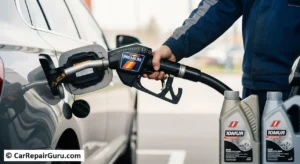
The best way to deal with an engine vibration is to never have one in the first place. While all parts eventually wear out, following a proactive maintenance routine can significantly extend the smooth-running life of your vehicle.
- Follow Your Vehicle’s Maintenance Schedule: That little booklet in your glove box is your car’s bible. It tells you when to perform crucial services like tune-ups (spark plugs, filters, etc.). Following it is the single best thing you can do.
- Use Quality Fuel and Fluids: Using Top Tier gasoline helps keep your fuel injectors clean. Regularly changing your oil with the correct type keeps internal components properly lubricated and running cool.
- Don’t Ignore Small Problems: A tiny squeak, a minor fluid drip, or a faint Check Engine Light are all precursors to bigger issues. Addressing them early is always cheaper and easier than waiting for a catastrophic failure.
- Get Your Tires Balanced and Rotated Regularly: This is cheap insurance. Most tire shops recommend a rotation and balance every 5,000-7,000 miles. It prevents uneven wear and keeps high-speed vibrations at bay.
Don’t Wait – Address That Shake Today
A vibrating engine is more than just an annoyance; it’s a critical symptom that deserves your immediate attention. By understanding what your car is telling you through the type and timing of the shake, you are now far better equipped to find the root cause.
For many, the fix might be a simple, rewarding DIY project. For others, the answer lies in the hands of a trusted professional. The most important thing is that you take action. Ignoring the problem will only lead to more damage and higher repair bills down the road.
Feeling overwhelmed or not sure where to start? Trust the experts. Our certified mechanics have the tools and experience to accurately diagnose the source of your engine vibration and get you back on the road safely and smoothly.
Your Engine Vibration Questions Answered
We get a lot of questions about this topic. Here are the answers to some of the most frequent ones.
Is it safe to drive with a vibrating engine?
It depends entirely on the cause and severity. A minor vibration from an unbalanced tire at highway speeds can be driven on cautiously until you can get to a shop. However, a severe shake, especially if paired with a flashing Check Engine Light, is a sign to pull over immediately. Driving with a severe misfire can quickly destroy your expensive catalytic converter. When in doubt, err on the side of caution and call for a tow.
Can low oil cause engine vibration?
Yes, but this is a sign of a very serious problem. Critically low oil levels mean your engine’s moving parts aren’t being lubricated. The resulting friction and heat can cause parts to grind, seize, and create a severe vibration. If you suspect this is the case, check your oil immediately. If it’s low, top it up, but understand that damage may have already occurred.
Can a transmission problem cause engine vibration?
Absolutely. The engine and transmission are bolted together and work as a single unit. Problems within the transmission, like a failing torque converter or worn-out internal clutch packs, can create vibrations that feel very similar to an engine issue. A key clue is if the vibration changes or disappears when you shift from Drive into Neutral.
How much does it cost to diagnose an engine vibration?
Most reputable auto repair shops charge a diagnostic fee to properly investigate an issue. You can expect this to be between $75 and $150. This fee covers the technician’s time to test drive the vehicle, check for codes, and inspect the likely culprits. In most cases, this fee is then applied toward the final cost of the repair if you choose to have them do the work.
